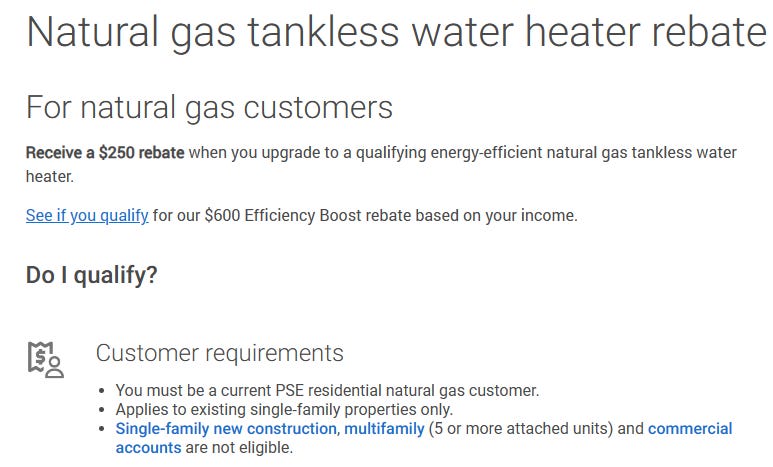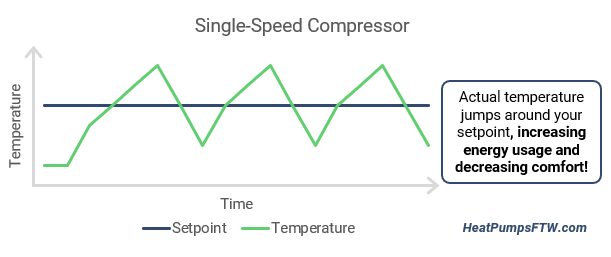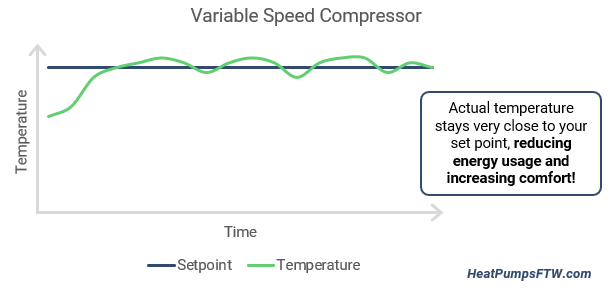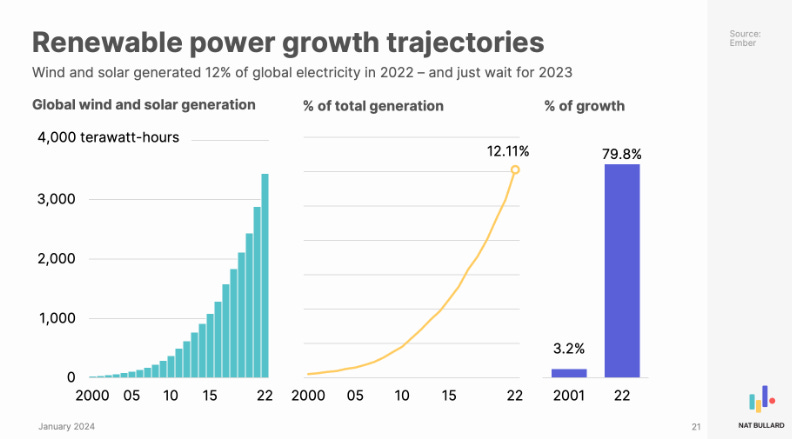One Program to Rule Them All: A Comprehensive Approach to Deep Decarbonization
How to wean our methane addiction, one home at a time.
Efficiency programs are an important tool for utilities. They allow investment into products that use less energy, rather than increasing energy supply through new generation or purchasing energy on the open market.
Not only does this help to keep rates low and reduce capital-intensive projects, offering rebates for high-efficiency equipment helps customers save money on their energy bills.
It’s a true win-win for utilities and their customers - and it works! While populations increase along with the number of TVs in our homes and other gadgets, average usage per household has trended down:
But these efficiency programs are changing as the goals of utilities, regulators, and other stakeholders are changing.
We are facing a climate crisis that requires us to rethink the way we produce and consume energy. This means “greening” the supply side with non-polluting energy sources like solar, wind, geothermal, nuclear, and more.
This further requires shifting the energy sources we use in our home - how we cook, how we heat our home in the winter, and how we heat our water.
Incrementally Better No Longer Works
Efficiency programs have historically worked on the concept of “incremental savings” - the energy saved by utilizing high-efficiency products instead of standard or code-minimum products.
A utility might offer you a rebate to purchase a gas furnace that has a 95% AFUE (annual fuel utilization efficiency), which means that 95% of the energy is converted to heat (5% energy loss). This is great, compared to standard models with an AFUE of 80%.
The same incremental approach is true across product and fuel source types: incandescent light bulbs to LEDs, low efficiency air conditioners to high efficiency units, and so on.
If our goal is to reduce and eventually eliminate the use of fossil fuels, we need a new approach. We can no longer incentivize more efficient gas appliance and must focus on fuel switching - using electric sources where gas has traditionally been used.
According to the EIA:
About 60% of U.S. homes use natural gas for space and water heating, cooking, and drying clothes.
It is even feasible to replace gas furnaces, water heaters, and stoves with some electric equivalent, and if so does it make financial sense to do so?
Moreover, given the scale of what needs to be accomplished, how should lawmakers, utilities, regulators, and other stakeholders approach this problem?
I will tackle these questions in the rest of this article and reveal an approach that is not only practical, but actually improves health outcomes, reduces costs for consumers, and improves grid stability.
Beneficial Electrification
The idea of replacing gas appliances with electric counterparts in order to reduce pollution, improve indoor air quality, increase comfort, and reduce costs is referred to as Beneficial Electrification.
The “beneficial” portion here is key - not all instances of electrification serve a useful purpose right away, whether due to technology barriers, infrastructure constraints, cost, or anything else.
The Beneficial Electrification League says this:
The Beneficial Electrification League's programs aim to accelerate the switch to electric end-uses where doing so advances one of the following objectives without counteracting the others: 1) reducing greenhouse gas emissions, 2) lowering costs for consumers, 3) improving quality of life, and/or 4) strengthening the grid.
With this idea in mind, let’s look at why the broad-based approach of traditional efficiency programs fall short of achieving the goal decarbonization.
Casting a Wide Net
Standard efficiency programs take the approach of “incremental savings” across a large region, generally within a single utility’s territory. Offer a $250 discount on a high-efficiency water heater, some customers will purchase and save some money on their energy bills.

After this transaction, utilities don’t have sophisticated means to continuing engaging this customer with further energy-saving opportunities. Maybe a follow up mailer or email, but there is generally no holistic approach or actual analysis of energy usage that might inform future options for saving energy.
This scattershot approach allows for the potential adoption of some high-efficiency products across a large market segment, but it does not address the gas use at that specific premise.
To be clear, there are some “whole home” programs that recommend and provide incentives for certain products, but these programs follow the old paradigm and generally do not promote electrification. And the rebates are often small where the customer still has a large out-of-pocket cost.
Depth, Not Breadth
A lot of people have looked at what it would take to actually stop using methane and transition to an electrified future. The only viable option is to take a holistic approach to each premise with the goal of reducing energy use intensity (EUI), then providing on-site generation and storage along with electrifying all appliances.
EUI is a metric used to express a building's energy use. It is typically measured as energy per square foot per year, calculated by dividing the total energy consumed by the building in one year by the total floor area of the building in square feet.
Program Structure - Deep Decarbonization
Why not take a scattershot approach and incentivize heat pumps to the point where they’re close to free?
This neglects the state of the premise as it stands now: is there adequate insulation? Does it need air sealing to patch holes in the building envelope? Is there adequate ventilation to prevent mold? All of these questions inform that location’s EUI. When you take simple, low-cost steps to reduce the EUI, the size of and therefore cost of the heat pump decreases.
That is the crux of the deep decarbonization approach: evaluate each premise, then proceed in a very specific order to reduce EUI. When you do this, the size of a solar array decreases to meet the location’s energy needs. The size of the heat pump can also be smaller. This reduces the upfront cost while ensuring all energy and comfort needs are met.
Who’s Paying For This!?!
A holistic approach requires funding beyond what most utilities are willing or able to provide. This is where state or the federal government can step in.
Government subsidies are nothing new - the federal government is already providing funding for efficiency, solar, and other infrastructure through the IIJA, IRA, and other bills. States provide tax credits for heat pumps, electric vehicles, and more. And this is not “green energy favoritism” - the US government subsidizes oil to the tune of $20 billion per year.
You may be thinking, “of course the government can throw money at something. That doesn’t mean it’s well spent or worth it for the taxpayer.” I’ll get to the numbers in the next section (hint: it’s a net positive for the taxpayer).
Beyond state and federal government support, a larger stakeholder group is necessary to truly make decarbonization work: non-profits, workforce training, utilities, third-party implementers, and many more.
Current Energy Cost Burden
The first thing you need is an understanding of current baseline costs: How much do you spend monthly and annually on energy bills? What is the maintenance and replacement costs of a gas furnace?
All of these costs need to be quantified to understand your full energy cost burden, understanding that there’s variation over time due to changing energy costs.
Reducing Your Energy Burden
There is a logical order of interventions to pursue when you are seeking to electrify. Following this order will reduce your EUI, improve air quality, and comfort. Not all steps here will be relevant for every location.
Pre-weatherization measures: address any structural issues, mold, or other factors that may prevent insulation and air sealing from doing what they’re intended to do.
Weatherization measures: It is crucial to ensure your home’s building envelope is well sealed and the attic, walls, and crawlspace are insulated. You want to make your home tight so that cold air does not easily penetrate your home in the winter.
Ventilation: The tighter your home’s envelope, the more important it is to provide intentional ventilation through bath fans, whole home fans, and other means.
New baseline: A blower door test will provide a new baseline for air leakage in your home, which will be much lower than before. A contractor will also perform a manual J. This helps informs your home’s heating and cooling needs, which allows you to adequately size a heat pump to meet those needs.
Panel upgrades: Depending on the size and age of your electrical panel, you may need an upgrade to accommodate the added electrical load (offsetting the prior methane usage) for your space and water heating needs.
Heat Pump (space heating and cooling): Install a heat pump, whether centrally ducted or ductless, sized appropriately for your climate zone.
Heat Pump Water Heater: This can be a straightforward install process, but it depends on your specific circumstances: the location of your current water heater, is it gas or electric, is it in a conditioned space, etc. By the way, a heat pump water heater is one of the most cost-effective options that pays for itself in a couple of years, especially if you have a standard electric water tank.
Bonus: In a perfect world, a solar array and battery would be installed around the same time as a heat pump. This is not viable for all locations for various reasons, but it is something to consider.
Double Bonus: When all of this work is done and you are not using methane anymore, you get to cap your gas line! Enjoy knowing that your indoor air quality has improved and you are not pumping noxious gas into your home anymore!
Rebates
Most utilities have rebates for all of the above items, along with state or federal rebates and tax credits. It’s a lot to keep track of, but it’s worth getting this right as it will save you thousands of dollars.
Luckily, there are a few resources out there to help. The best place to start is Rewiring America’s Electrification Planning Tool. There you can find cost estimates for all the items mentioned above, as well as an overview of rebates you might qualify for.
Financing
So you’ve looked at the cost of all this work and the rebates. Still, your out-of-pocket cost might be substantial, especially if you are installing solar and a battery array. What do you do now? Finance the balance.
You might be asking, why would I want to take on more debt for all this? I can’t afford it! Well, the good news is that there are a lot of low-interest financing options for energy upgrades.
A few examples:
The city of Toronto offers long-term, low-interest financing for low-carbon, energy-efficient capital improvements. The interest rate is equal to the city's cost of borrowing, and repayment terms can be up to 30 years.
The Colorado Clean Energy Fund offers a Residential Energy Upgrade Loan Program, up to $75,000 with interest rates starting at 2.74%. These loans are secured by a UCC-1 filing on installed measures only; no lien placed on property.
There are many other options, including tariffed on-bill financing. As with the Colorado example above, this means the loan is tied to the premise itself and not to the individual. So if you move, the loan doesn’t follow you - it stays with the property and the new owner.
Even With Financing, This Seems Expensive!
Let’s look at what a real-world loan might cost. Assuming you’ve maximized your rebate potential, you might still have $35,000 out pocket costs to cover the balance of the solar array, heat pump, and other items.
A $35,000 loan at 2.74% over a 15-year period is $241.70 per month. Most people don’t have an extra $250 laying around for this. But remember - you don’t have a gas bill anymore! Look at your average gas bill over the past 12 months. Consider any spikes in prices you might’ve experienced (looking at you Texas and Winter Storm Uri).
If your gas bill averaged ~$100 month, your net cost is now about $131/month. Be sure to look at access fees on your utility bill as well, but just usage fees. Those will also go away.
Because of the weatherization work you did, your EUI should be lower than before, so total energy needs should go down.
Additionally, if you were able to install a solar array (even without a battery), that could be enough to offset the remaining $131/month cost. This of course depends on where you live, how much sunshine you get, your roofs orientation, size of the array, etc.
Non-Monetary Benefits
Even if you end up spending a bit more than before, you now have a massive benefit that you did not have before: increased comfort and air quality!
Modern heat pumps use variable speed compressors, which means they do not just cycle on and off around the set point on your thermostat.
A gas furnace set to 68 degrees will turn on, hit that temperature and often overshoot it. Then it turns off, falls below 68, then turns on again.
This simple functionality is driven be a fixed-speed compressor: turn on when told by the thermostat, turn off when target temperature is met.
This often results in temperature swings of a few degrees around your set point, resulting in a less comfortable and less consistent temperature.
This "start-and-stop" process can be inefficient because it uses a high amount of energy when starting up and doesn't always meet the exact temperature needs of a home, leading to fluctuations in comfort levels.

Unlike a fixed-speed compressor that is either on or off, a variable-speed compressor allows for a smooth increase or decreases in output. It's a bit like the gas pedal in a car. Instead of simply being on or off, it can adjust its speed based on the amount of heating or cooling required.
They not only provide more consistent indoor temperature but also maximizes energy efficiency. With these compressors, the heat pump uses only the amount of energy necessary to maintain comfort levels, which can lead to significant energy savings.

All of this is to say - you will be more comfortable with consistent temperatures thanks to your awesome new heat pump!
Cost of Energy
The one ever changing variable in all of this is the cost of energy. Just like everything else, the cost of electricity tends to rise over time. But utilities have certain tools they can use to help manage your energy costs: rate schedules.
About half of all utilities in the United States have some kind of “time of use” (TOU) rate schedule. Most of these are optional, but if you are on a TOU rate, the goal is to encourage you to use less energy during peak demand periods to help ease strain on the grid.
While we are not there yet, utilities are developing specific rate schedules for electrification. Because in a lot of cases, methane is cheaper than electricity. So electrifying does not automatically imply lower energy bills. For many homeowners, it does. But for the rest, utilities are developing tools to help homeowners manage this and achieve parity with gas costs.
This is why examining actual energy usage can help inform which homes will benefit financially right now from electrifying, and which ones might need other interventions first (like weatherization upgrades) and the need to be on a specific utility rate schedule.
This also further illustrates the importance of generating and storing your own energy - if possible!
Societal Benefits
Electrification extends beyond the comfort and air quality benefits of each home - there are societal benefits as well. Better indoor air quality reduces instances of childhood asthma and other respiratory ailments, reducing overall health care costs.
On the supply side, as generation keeps trending towards non-fossil fuel sources, this impact multiplies.

Estimated annual deaths from fossil fuel pollution ranges from 3 to more than 8 million people. Not to mention the costs of non-fatal health impacts from air pollution, and future societal costs of climate change.
The point is, governments are slowing coming to the realization that “first costs” associated with electrification are actually investments that more than pay for themselves by reducing costs and deaths associated with air pollution and maintaining a healthy population and environment.
Putting All the Pieces Together
Deep decarbonization takes a village. Skilled trades in home energy assessments, weatherization, HVAC, utilities, financing institutions, non-profits, advocacy groups, and more.
How does this all come together? By the above stakeholders working together and creating a simple ecosystem that follows this path:
Complete upgrades in the order mentioned above.
A rebate portal that stacks everything in one place for ease of use.
Bundled financing for the rest of the work at a low-interest rate.
It’s a lot, and there’s a lot of work to do to develop a larger workforce, drive product costs down, and create this comprehensive framework. But it is happening.
Each home needs to be treated individually. Big rebates on a single product type don’t get us there. Holistically looking at each premise and developing a unique plan creates a pathway to increase the comfort of that home and cap the gas line. Multiply this by a few million…we might just save the world.
Chris Prato, creator of WattMind, combines 16 years of energy industry experience with a passion for clean energy and AI. With degrees in Mathematics, Philosophy, and an MBA, Chris offers unique insights into the world of AI-driven energy tech. Follow Chris on LinkedIn or Threads for more energy hot takes.



